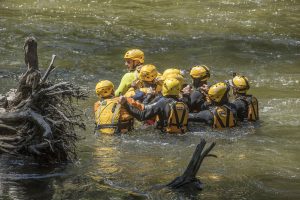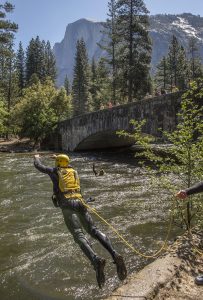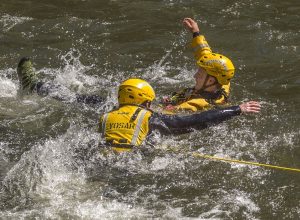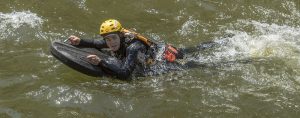YOSEMITE — With record snow pack this year, rivers are running very fast and cold, posing a potential danger to park visitors. Authorities are asking people to stay a safe distance from rivers during spring runoff, which is expected to last several more weeks.
On Thursday, May 25, Yosemite National Park Rangers conducted a Swiftwater Rescue Training and Water Safety Day on the Merced River in Yosemite Valley. The training was conducted to train Park Rangers on rescue techniques and to educate the public on potential dangers related to swift and high water conditions.
One Yosemite Search and Rescue (YOSAR) swift water rescue coordinator likened the extreme nature of river recreation to being trapped, standing on a busy highway with cars speeding by.
“If you fall in, things happen really fast, whether you’re getting hit by a side mirror on the freeway or you’re getting your breath knocked out of you in the river because the water is so cold. You’re completely disoriented. It’s the same level of danger and has the same outcome.”
Having the right gear is essential for rescue.
The water temperature at this time of year is between 42 and 50 degrees. The river is running at thousands of cubic feet per second, an exceptionally high volume due to the heavy snow pack now melting. The water is cold enough that after four to five minutes your hands stop working effectively.
Rangers who engage in rescue efforts would typically enter the frigid water wearing a special helmet and insulated dry suit, equipped with a rescue personal flotation device (PDF) which the team affectionately calls a “drowning vest,” because “if you don’t know how to use it, this gets you into a lot of trouble.”
Defensive swimming is a must if you fall in.
YOSAR experts talk about the need for defensive swimming, which includes positioning the body to avoid entrapment in the near-freezing water.
The temperature is cold enough that it takes people’s breath away if they fall in, and they quickly lose track of a secure position in the water. Automatically, the feet come down to find purchase in the river’s bottom. The problems start with the possibility of getting your foot stuck in the crevice of a rock or tree. The force of the water would continue pushing you over and you can’t get back up to breathe.
The biggest thing to remember, say rescuers, is defensive footing. That means positioning yourself on your back with your feet pointing downstream, head above water, kind of like you’re reclining in a lawn chair.
YOSAR’s Mutlow put it this way: “You aggressively point your feet downstream and do everything you can to get your head above water and be able to look at your toes. If you can get in that position where you’re on your back, then your butt is taking the hits, not your stomach or your chest. Now you’re actually in a position where you can be defensive when you encounter an obstacle.”
Avoid standing up in the river because “you’re never quite sure what is down there.”
Hazards of rope rescue and downstream containment.
Another essential trick used in swift water river rescue is rope throwing from the shore. This is extremely perilous for those who are untrained.
“You have to go out with the right equipment, otherwise you are going to become a statistic really fast. The motivation with young people, particularly, is that they automatically go in the water to help, often creating a tragic situation where more than one person is lost,” explains Mutlow.
Sometimes it’s necessary for rescuers to employ a technique for downstream containment.
“Maybe we’ve had a big raft flipped upstream and we are anticipating someone floating down. So we are going to provide protection downstream so they don’t wash ever further down the river. There could be a massive waterfall, for instance, so we really want to ensure that they don’t make it any farther down.”
At the point of hypothermia, a victim may not even be able to grab onto a rope.
“We’re actually going to grab on to them and bring them back to shore, and it could even be someone who’s unconscious. The technique of rescuing a ‘baited swimmer’ is slightly more dangerous for us.”
Team communicates with signals and whistles.
Signals and whistles are critical to rescue operations in the water.
With whistles, rangers say it’s one blast for attention, two blasts for something up stream, three blasts for downstream. They use three long repeated blasts for an emergency, in the case of someone hurt or something that requires immediate attention.
Noise canceling headphones and other technology such as radios are available to assist communication during a rescue, but rescuers agree the age-old techniques of expert swimming, signals, and flotation devices work best most of the time.
SAR demonstrates highline technique used for rescue and recovery.
A highline rescue technique employs a series of ropes, weights and pulleys across a body of water.
About a dozen people are involved in pulling and releasing lines in order to maneuver the rescuer precisely over the spot in the river where they need to be. YOSAR uses the highline if someone is in the middle of the river needing a rescue, or if there is a recovery in the middle of the river and authorities send someone out to get bring the body back.
Responders warn of under-estimating danger while over-estimating ability.
A search and rescue can include dozens of individuals from all over Yosemite if a situation warrants. Fortunately, search and recovery is not as frequent a scenario as the lower-body injuries that park personnel treat daily during the height of visitor season.
In the summer, paramedics see nearly innumerable lower leg injuries and sprained and broken ankles. They also treat many patients who are stricken with dehydration and hyponatremia, which occurs when a person drinks plenty of water and then sweats out their electrolytes and salts. If a park visitor in that position hasn’t been eating all day, it can seem like dehydration to the untrained observer.
The best advice from all the experts is to follow the rules when hiking.
“Stay on the trail,” say emergency medical responders. Going off trail, they say is “pretty much the number one thing that gets people into a lot of trouble in terms of injuries or being lost or injured or killed.”
They warn visitors to know their own limits and understand the perils of the park.
“Don’t come unprepared or out of shape for whatever activity you’re doing. Know your own limits and be respectful of the park. There’s a lot of beauty here and a lot of danger as well. Respect the water, respect the mountains, respect the cliffs. They are beautiful, but they can hurt you.”







